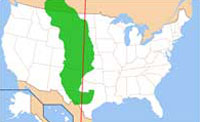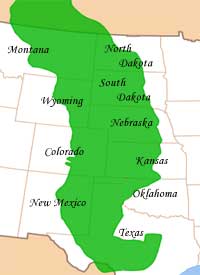The Great Plains is the broad expanse of prairie which lies east of the Rocky Mountains in the United States of America and Canada, covering the US states of New Mexico, Texas, Oklahoma, Colorado, Kansas, Nebraska, Wyoming, Montana, South Dakota and North Dakota and the Canadian provinces of Saskatchewan and Alberta. Much of Minnesota and Iowa and much of the Canadian province of Manitoba also lies in the Great Plains.

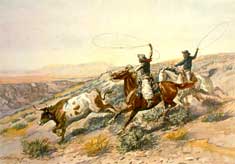 The High Plains refers to the elevated region of the Great Plains generally west of the 100th meridian, which roughly corresponds with the line west of which there is 20 inches of rainfall a year or less. The region is arid and generally characterized by rangeland or marginal farmland. About every 25 years the region is subject to drought and may be subject to devastating duststorms. The region roughly centered on the Oklahoma Panhandle, including southeastern Colorado, southwestern Kansas, the Texas Panhandle, and extreme northeastern New Mexico was known as the Dust Bowl during the late 1920s and early 1930s. The effect of the drought combined with the effects of the Great Depression, and many farmers were forced off the land throughout the Great Plains. Another drought has struck the area in recent years. The High Plains refers to the elevated region of the Great Plains generally west of the 100th meridian, which roughly corresponds with the line west of which there is 20 inches of rainfall a year or less. The region is arid and generally characterized by rangeland or marginal farmland. About every 25 years the region is subject to drought and may be subject to devastating duststorms. The region roughly centered on the Oklahoma Panhandle, including southeastern Colorado, southwestern Kansas, the Texas Panhandle, and extreme northeastern New Mexico was known as the Dust Bowl during the late 1920s and early 1930s. The effect of the drought combined with the effects of the Great Depression, and many farmers were forced off the land throughout the Great Plains. Another drought has struck the area in recent years.
The southern portion of the Great Plains lies over the Ogallala Aquifer, a vast underground layer of water-bearing strata dating from the last ice age. Center pivot irrigation is used extensively, but the aquifer is being depleted at a rate that is not sustainable.

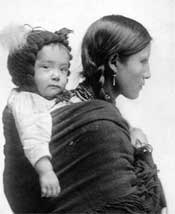 Historically the Great Plains were the range of the bison and of the Great Plains culture of the Native American tribes of the Blackfeet, Crow, Sioux, Cheyenne, Arapaho, Comanche and others. Historically the Great Plains were the range of the bison and of the Great Plains culture of the Native American tribes of the Blackfeet, Crow, Sioux, Cheyenne, Arapaho, Comanche and others.
After the near-extinction of the buffalo and the removal of the Native Americans to Indian reservations, the Great Plains were devoted to ranching and were open range, that is, anyone was theoretically free to run cattle. In the spring and fall, roundups were held and the new calves were branded and the cattle sorted out for sale. Ranching began in Texas and gradually moved northward. Texas cattle were driven north to the railroad, especially to Dodge City, Kansas, then shipped eastward by rail. Many foreign, especially British, investors financed the great ranches of the era. Overstocking of the range and the terrible winter of 1886 eventually resulted in a disaster with many cattle starved and frozen. From then onward, ranchers generally turned to raising feed in order to winter their cattle over.
The Homestead Act of 1862 provided that a settler could claim up to 160 acres of land provided he lived on it for a period of years and cultivated it. This was later expanded to include a homestead of an entire section. Hundreds of thousands of Americans and immigrants proved up homesteads, sometimes building sod houses out of the very turf of their land. Many of them were not skilled dryland farmers and failures were frequent. Germans from Russia who had previously farmed in similar circumstances in what is now Ukraine were marginally more successful than the average homesteader. The Dominion Lands act of 1871 served a similar function in Canada.
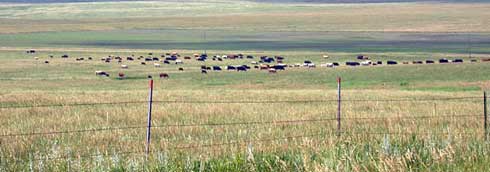
The rural Plains has lost a third of its population since 1920. Several hundred thousand square miles of the Great Plains have less than 6 persons per square mile - the density standard Frederick Jackson Turner used to declare the American Frontier "closed" in 1893. Many have less than 2 persons per square mile. There are more than 6,000 ghost towns in the State of Kansas alone, according to Kansas historian Daniel Fitzgerald. This problem is often exacerbated by the consolidation of farms and the difficulty of attracting modern industry to the region. In addition, the smaller school-age population has forced the consolidation of school districts and the closure of high schools in some communities. This continuing population loss has led some to suggest that the current use of the drier parts of the plains is not sustainable, and propose that large parts be restored to native grassland grazed by buffalo, a proposal known as Buffalo Commons.
|
